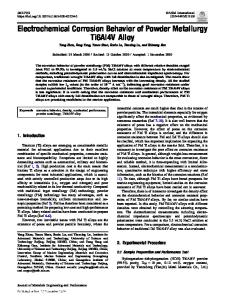Corrosion Electrochemical Behavior of Surface-Modified Titanium Alloys
- PDF / 460,639 Bytes
- 6 Pages / 612 x 792 pts (letter) Page_size
- 8 Downloads / 343 Views
CORROSION ELECTROCHEMICAL BEHAVIOR OF SURFACE-MODIFIED TITANIUM ALLOYS V. I. Pokhmurs’kyi, O. S. Kalakhan, and H. H. Okhota
UDC 620.197
We have studied the corrosion electrochemical properties of titanium TS-5 pseudo-α alloy and VT-6 ( α + β )-alloy after high-energy ( E = 30 keV ) ion implantation with nitrogen (with a 17
2
fluence of 2 ⋅ 10 ion / cm ) and subsequent annealing in vacuum at a temperature of 803 K for 2 h, with a coating of titanium nitride and without it. To determine the limiting stages of the corrosion process and anodic dissolution of modified surfaces in 3% NaCl aqueous solution within the temperature range 293 – 363 K, we applied the temperature-kinetic method. It has been shown that the modification of the surface with nitrogen affects the potential of passivation beginning and the range of potentials of the passive region. We have also established that the structure of surface films determines the dissolution energy and effective activation energy.
The ion implantation of nitrogen into the surface of titanium alloys leads to the formation of titanium nitrides with a high microhardness (18 – 20 GPa), which enhance significantly the surface strength and wear resistance. However, the effect of ion alloying with nitrogen on the corrosion electrochemical behavior of alloys in corrosive environments [1 – 4] at elevated temperatures has not been clarified completely. In the present work, we study the temperature variation of the corrosion electrochemical properties of surface-modified titanium alloys in electrolyte solutions. Procedure of Investigations We modified the surface layers of titanium TS-5 pseudo-α alloy (Ti–5Al–2Zr–3Sn–2V) and VT-6 (α + β)alloy (Ti–6Al–4V) on a specialized equipment for the ion implantation of nitrogen and coating with titanium nitrides. The specimens were irradiated with high-energy (30 keV) nitrogen ions with a fluence of 2 ⋅ 1017 ion / cm2 and afterwards annealed in vacuum at 803 K for 2 h. Ion-plasma coatings of titanium nitrides were applied for 2 h. The microstructure of alloys was studied on metallographic sections perpendicular to the irradiated surface. We determined the corrosion electrochemical properties of these alloys in distilled water and 3% NaCl solution at temperatures of 293 – 343 K by the potentiodynamic method with a potential scanning rate of 2 mV / sec, using an SVA-1B-M voltammetric system. An ÉVL-1M1-type chlorine-silver electrode served as a reference electrode. We calculated the effective activation energy of corrosion and anodic dissolution of the modified alloys under an overvoltage Δ E = 0 – 2 V by polarization polythermic curves, crossing them with isopotential lines [5], and constructing the temperature dependence of the current density under conditions of constant electrolytic polarization [6]. Experimental Results and Discussion For the values of energy and fluence given above, implanted ions can move through the crystal lattice and penetrate deep into the material [7], inducing volume damages in a thin near-surface layer. Ion impl
Data Loading...











